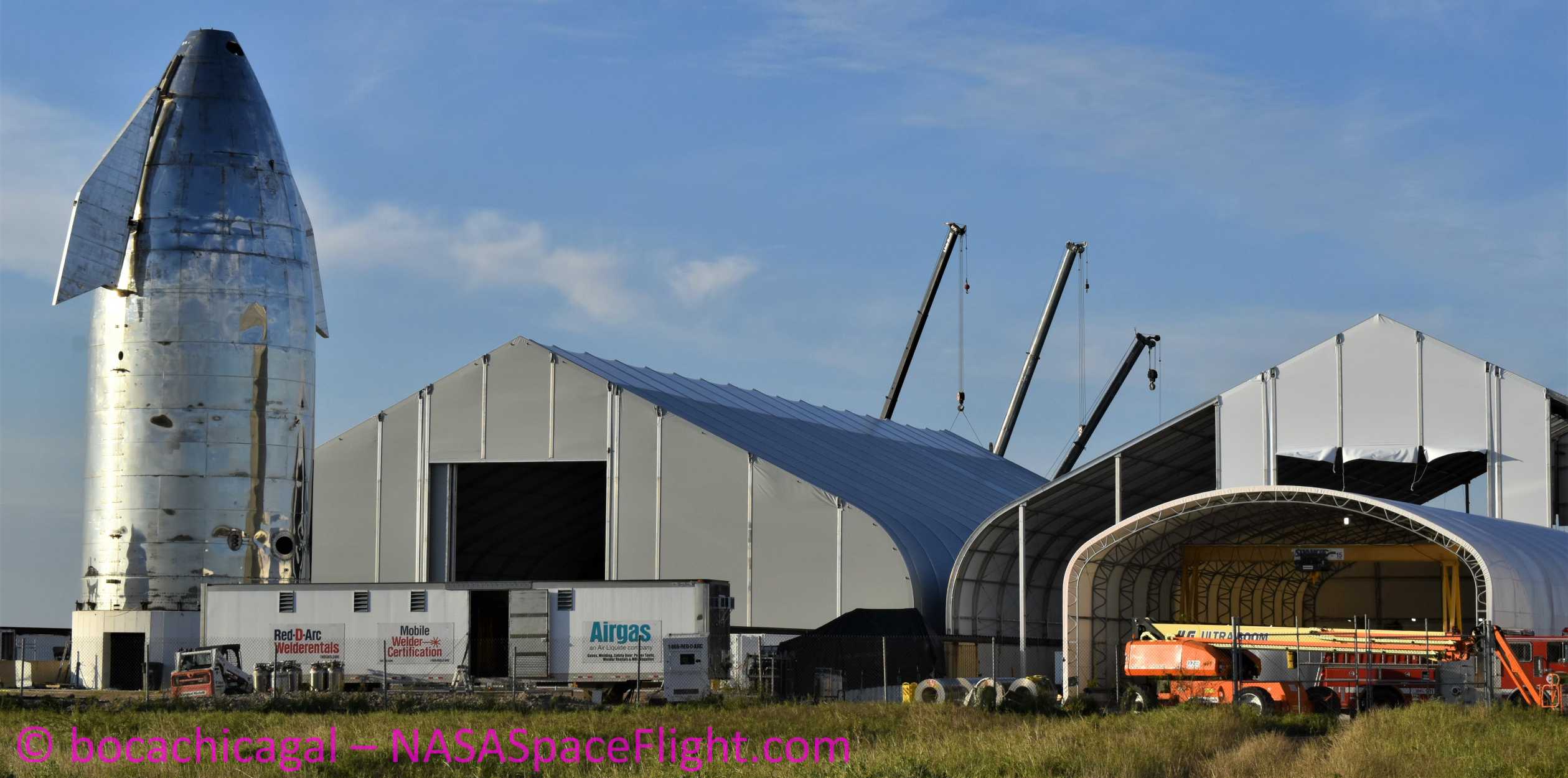
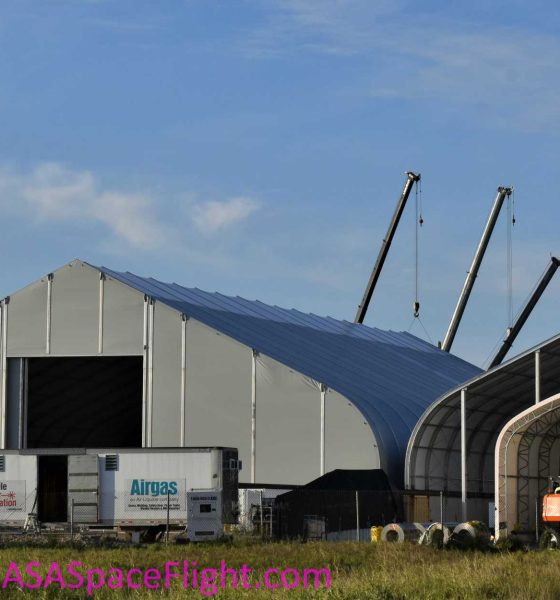
News
SpaceX ramps Starship hiring as Elon Musk talks Texas rocket factory's "awesome" progress
After several successful tests last month, Elon Musk says that SpaceX’s South Texas Starship team is looking to rapidly expand in order to aggressively ramp up Starship manufacturing in a sign that the nascent rocket factory is making excellent progress.
Almost immediately after SpaceX successfully wrapped up its first and second explosive Starship tank tests last month, the company’s Boca Chica, Texas presence started to take on a new atmosphere, reminiscent of the rapid progress made at a since-mothballed Florida Starship facility. Perhaps thanks to the fact that SpaceX’s Boca Chica Starship facilities are adjacent to a dedicated test and launch facility just a mile down the road, it’s looking much less likely that a similar fate will befall its Texas presence.
Instead, SpaceX’s successful Starship tank tests – intentionally destroying two massive propellant tanks – are a testament to the progress the next-generation rocket is making in Texas. In fact, SpaceX CEO Elon Musk has effectively stated that after the most recent tank test, the company is now ready to shift gears and start building the first space-bound Starship prototypes, while the last week or two of SpaceX’s visible Texas activities make it clear that that shift is already well underway.
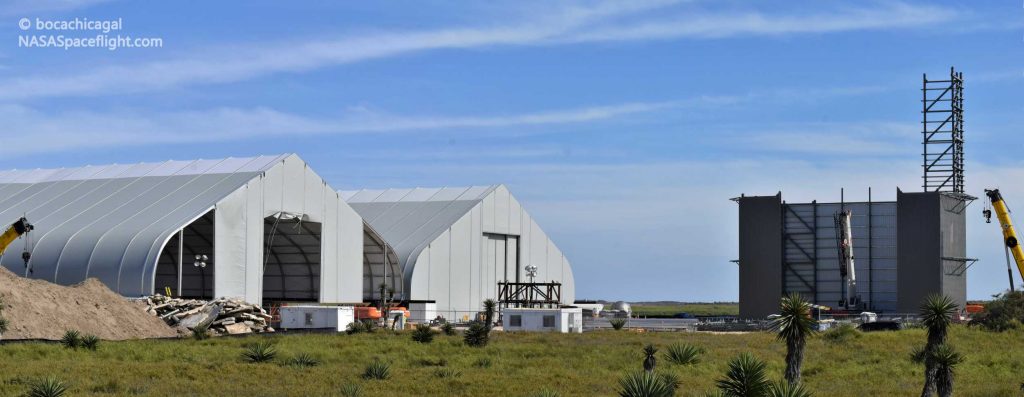
In simple terms, SpaceX now appears to be moving full speed ahead in a bid to manufacture, assemble, and test the first flightworthy, full-scale Starship prototypes. It’s worth noting that CEO Elon Musk has underestimated the challenge at hand several times in the last 18 or so months of Starship development, frequently suggesting that the first full-scale prototype of the spacecraft would be ready for a challenging flight test and maybe even its first orbital flights as early as 2019.
For a number of reasons, those ambitious targets were not met. To Musk’s credit, the executive is at least conscious of his tendency to be wildly optimistic when it comes to schedules and has effectively tacked on an asterisk that the schedules and deadlines he often publicizes tend more along the lines of “this time-frame is technically possible without breaking the laws of physics” than anything verging on pragmatism. With challenges as complex as those faced in spaceflight, let alone massive, fully-reusable rockets like Starship, it’s hard to be surprised that practical deadlines tend to be miles away from theoretically-possible minimums.
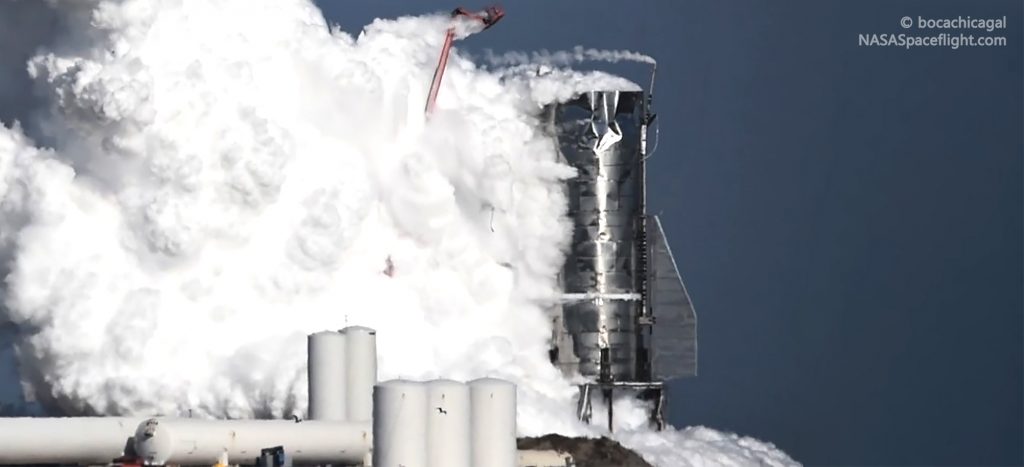
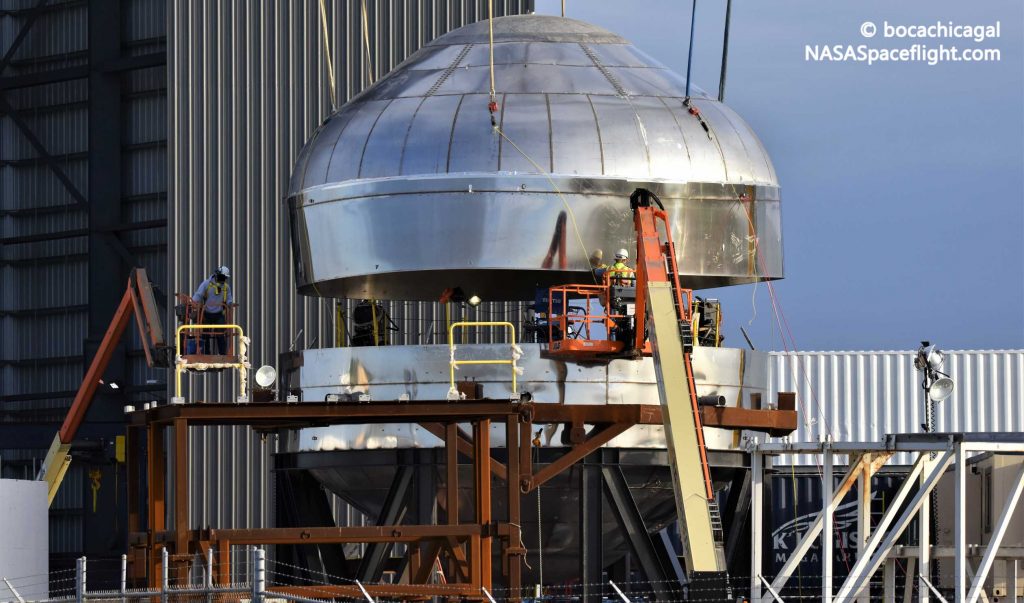
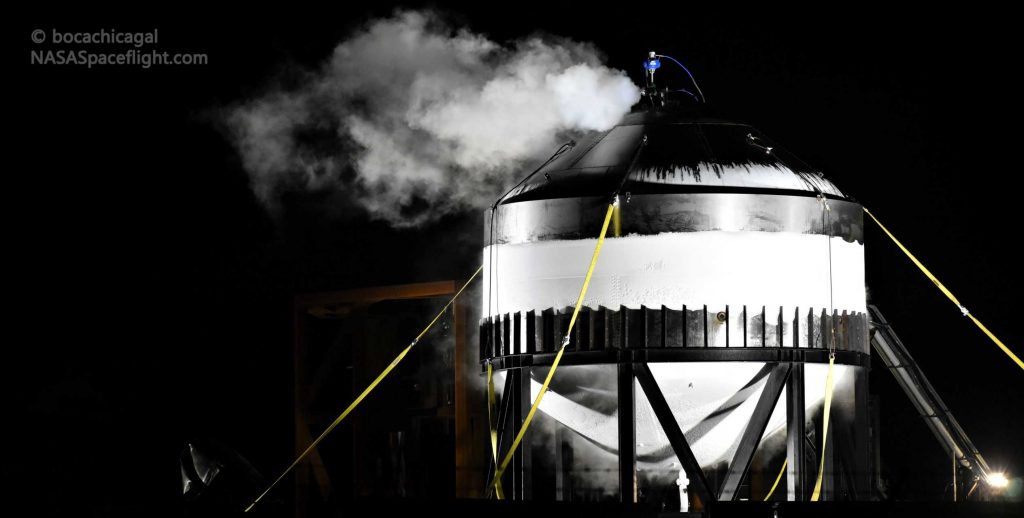
As such, it wouldn’t be unreasonable to feel a bit like the townspeople with a boy crying wolf, but there are arguably several reasons for optimism, this time around. Most importantly, as partially pictured above, SpaceX has completed four intentionally destructive tests with full-scale Starship hardware in just the last 2.5 months. Deemed unfit for flight, SpaceX pressurized Starship Mk1 with liquid nitrogen until it burst in November 2019, reaching an estimated 3-5 bar (45-75 psi).
SpaceX spent the following month upgrading both the methods and facilities used to build Starship prototypes in South Texas – a process that is still very much ongoing. However, two recent tests of Starship tanks built with some of those new methods and facilities have unequivocally proven that great progress is being made. The first ‘test tank’ managed 7.1 bar (105 psi) before it burst, while a second tank completed less than three weeks later reached 7.5 bar (110 psi) with water and 8.5 bar (125 psi) with liquid nitrogen on January 28th. Between those tests, Musk revealed that 6 bar was the bare minimum necessary for orbital Starship flights, while 8.5 bar would potentially offer the safety margins needed for crewed Starship flights.
In other words, SpaceX’s last two tank tests have effectively proved that – even with facilities and methods only partially upgraded – the company is ready to begin manufacturing the first truly flight-rated Starship prototypes. In response, Musk recently stated that he was going “max hardcore on” Starship design and production in Boca Chica and revealed that SpaceX would host a second South Texas jobs fair in three weeks to help rapidly staff its growing rocket factory.
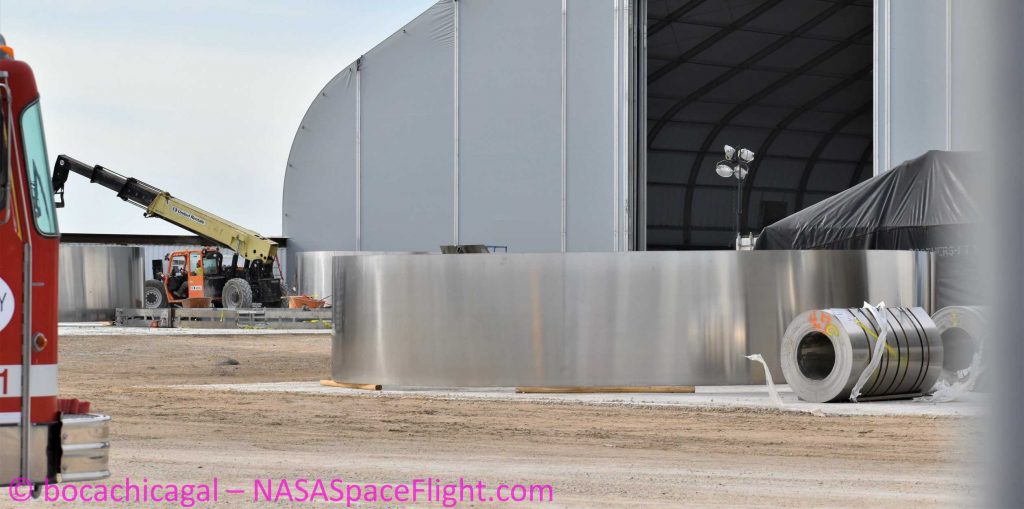
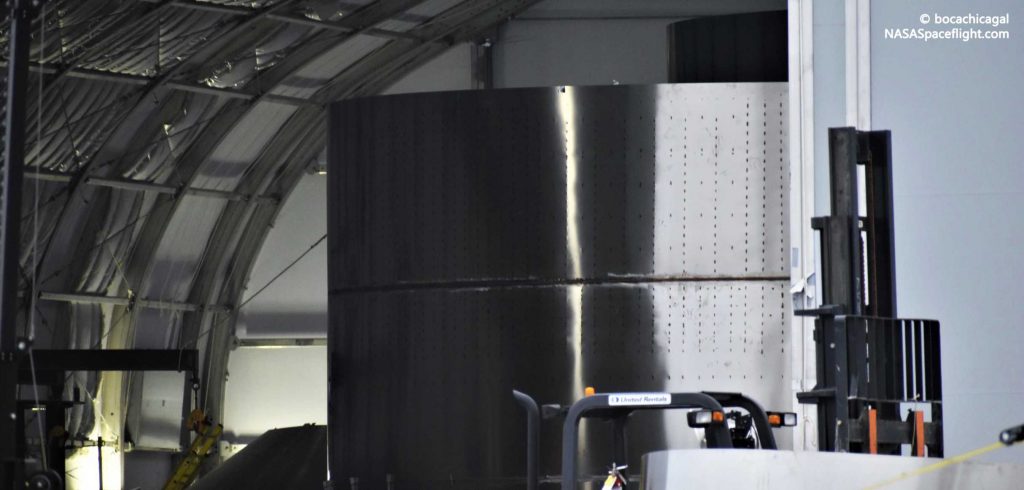
Looking at the progress SpaceX has made in just the last week, it’s hard to fault Musk’s brimming enthusiasm. Now breaking in new semi-automated welding machines, upgraded production equipment, and two massive sprung structures (i.e. tents), SpaceX engineers and technicians are churning out improved steel rings, tank domes (bulkheads), smaller propellant tanks, and more at a breakneck pace relative to the last year of Starship work. Additionally, at least six of those new rings have been stacked together in two sections, likely representing the effective birth of the first flightworthy Starship – ‘SN01’.
With SpaceX’s new enclosed facilities, much of its South Texas work is now hidden. Still, from what’s visible, it’s safe to say that the company is well its way to completing the first flight – and possibly orbit – worthy Starship prototypes in the near future.
Check out Teslarati’s Marketplace! We offer Tesla accessories, including for the Tesla Cybertruck and Tesla Model 3.

Cybertruck
Tesla updates Cybertruck owners about key Powershare feature

Tesla is updating Cybertruck owners on its timeline of a massive feature that has yet to ship: Powershare with Powerwall.
Powershare is a bidirectional charging feature exclusive to Cybertruck, which allows the vehicle’s battery to act as a portable power source for homes, appliances, tools, other EVs, and more. It was announced in late 2023 as part of Tesla’s push into vehicle-to-everything energy sharing, and acting as a giant portable charger is the main advantage, as it can provide backup power during outages.
Cybertruck’s Powershare system supports both vehicle-to-load (V2L) and vehicle-to-home (V2H), making it flexible and well-rounded for a variety of applications.
However, even though the feature was promised with Cybertruck, it has yet to be shipped to vehicles. Tesla communicated with owners through email recently regarding Powershare with Powerwall, which essentially has the pickup act as an extended battery.
Powerwall discharge would be prioritized before tapping into the truck’s larger pack.
However, Tesla is still working on getting the feature out to owners, an email said:
“We’re writing to let you know that the Powershare with Powerwall feature is still in development and is now scheduled for release in mid-2026.
This new release date gives us additional time to design and test this feature, ensuring its ability to communicate and optimize energy sharing between your vehicle and many configurations and generations of Powerwall. We are also using this time to develop additional Powershare features that will help us continue to accelerate the world’s transition to sustainable energy.”
Owners have expressed some real disappointment in Tesla’s continuous delays in releasing the feature, as it was expected to be released by late 2024, but now has been pushed back several times to mid-2026, according to the email.
Foundation Series Cybertruck buyers paid extra, expecting the feature to be rolled out with their vehicle upon pickup.
Cybertruck’s Lead Engineer, Wes Morrill, even commented on the holdup:
As a Cybertruck owner who also has Powerwall, I empathize with the disappointed comments.
To their credit, the team has delivered powershare functionality to Cybertruck customers who otherwise have no backup with development of the powershare gateway. As well as those with solar…
— Wes (@wmorrill3) December 12, 2025
He said that “it turned out to be much harder than anticipated to make powershare work seamlessly with existing Powerwalls through existing wall connectors. Two grid-forming devices need to negotiate who will form and who will follow, depending on the state of charge of each, and they need to do this without a network and through multiple generations of hardware, and test and validate this process through rigorous certifications to ensure grid safety.”
It’s nice to see the transparency, but it is justified for some Cybertruck owners to feel like they’ve been bait-and-switched.
News
Tesla’s northernmost Supercharger in North America opens

Tesla has opened its northernmost Supercharger in Fairbanks, Alaska, with eight V4 stalls located in one of the most frigid cities in the U.S.
Located just 196 miles from the Arctic Circle, Fairbanks’s average temperature for the week was around -12 degrees Fahrenheit. However, there are plenty of Tesla owners in Alaska who have been waiting for more charging options out in public.
There are only 36 total Supercharger stalls in Alaska, despite being the largest state in the U.S.
Eight Superchargers were added to Fairbanks, which will eventually be a 48-stall station. Tesla announced its activation today:
North America’s northernmost Supercharger Fairbanks, AK (8 stalls) opened to public. https://t.co/M4l04DZ6B5 pic.twitter.com/zyL6bDuA93
— Tesla Charging (@TeslaCharging) December 12, 2025
The base price per kWh is $0.43 at the Fairbanks Supercharger. Thanks to its V4 capabilities, it can charge at speeds up to 325 kW.
Despite being the northernmost Supercharger in North America, it is not even in the Top 5 northernmost Superchargers globally, because Alaska is south of Norway. The northernmost Supercharger is in Honningsvåg, Norway. All of the Top 5 are in the Scandanavian country.
Tesla’s Supercharger expansion in 2025 has been impressive, and although it experienced some early-quarter slowdowns due to V3-to-V4 hardware transitions, it has been the company’s strongest year for deployments.
🚨🚨 Tesla Supercharging had a HUGE year, and they deserve to be recognized.
🍔 Opened Tesla Diner, a drive-in movie theater with awesome, Chef-curated cuisine
🔌 Gave access to Superchargers to several EV makers, including Hyundai, Genesis, Mercedes-Benz, Kia, Lucid, Toyota,… pic.twitter.com/yYT2QEbqoW
— TESLARATI (@Teslarati) December 10, 2025
Through the three quarters of 2025, the company has added 7,753 stations and 73,817 stalls across the world, a 16 percent increase in stations and an 18 percent increase in stalls compared to last year.
Tesla is on track to add over 12,000 stalls for the full year, achieving an average of one new stall every hour, an impressive statistic.
Recently, the company wrapped up construction at its Supercharger Oasis in Lost Hills, California, a 168-stall Supercharger that Tesla Solar Panels completely power. It is the largest Supercharger in the world.
News
Tesla shocks with latest Robotaxi testing move
Why Tesla has chosen to use a couple of Model S units must have a reason; the company is calculated in its engineering and data collection efforts, so this is definitely more than “we just felt like giving our drivers a change of scenery.”

Tesla Model S vehicles were spotted performing validation testing with LiDAR rigs in California today, a pretty big switch-up compared to what we are used to seeing on the roads.
Tesla utilizes the Model Y crossover for its Robotaxi fleet. It is adequately sized, the most popular vehicle in its lineup, and is suitable for a wide variety of applications. It provides enough luxury for a single rider, but enough room for several passengers, if needed.
However, the testing has seemingly expanded to one of Tesla’s premium flagship offerings, as the Model S was spotted with the validation equipment that is seen entirely with Model Y vehicles. We have written several articles on Robotaxi testing mules being spotted across the United States, but this is a first:
🚨 Tesla is using Model S vehicles fitted with LiDAR rigs to validate FSD and Robotaxi, differing from the Model Ys that it uses typically
Those Model Y vehicles have been on the East Coast for some time. These Model S cars were spotted in California https://t.co/CN9Bw5Wma8 pic.twitter.com/UE55hx5mdd
— TESLARATI (@Teslarati) December 11, 2025
Why Tesla has chosen to use a couple of Model S units must have a reason; the company is calculated in its engineering and data collection efforts, so this is definitely more than “we just felt like giving our drivers a change of scenery.”
It seems to hint that Tesla could add a premium, more luxury offering to its Robotaxi platform eventually. Think about it: Uber has Uber Black, Lyft has Lyft Black. These vehicles and services are associated with a more premium cost as they combine luxury models with more catered transportation options.
Tesla could be testing the waters here, and it could be thinking of adding the Model S to its fleet of ride-hailing vehicles.
Reluctant to remove the Model S from its production plans completely despite its low volume contributions to the overall mission of transitioning the world to sustainable energy, the flagship sedan has always meant something. CEO Elon Musk referred to it, along with its sibling Model X, as continuing on production lines due to “sentimental reasons.”
However, its purpose might have been expanded to justify keeping it around, and why not? It is a cozy, premium offering, and it would be great for those who want a little more luxury and are willing to pay a few extra dollars.
Of course, none of this is even close to confirmed. However, it is reasonable to speculate that the Model S could be a potential addition to the Robotaxi fleet. It’s capable of all the same things the Model Y is, but with more luxuriousness, and it could be the perfect addition to the futuristic fleet.








